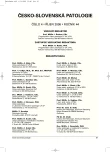The Taphonomic Aspects of Cadaverous Changes in Corpses, Buried in the Plastic Foils
Authors:
F. Štuller 1; Ľ. Straka 2; V. Macko 2; D. Krivoš 2; J. Krajčovič 1; F. Novomeský 1
Authors‘ workplace:
Ústav súdneho lekárstva a medicínskych expertíz Jesseniovej lekárskej fakulty UK, Martin.
1; Súdnolekárske pracovisko Úradu pre dohľad nad zdravotnou starostlivosťou, Martin
2
Published in:
Soud Lék., 53, 2008, No. 4, p. 46-50
Overview
The forensic expertise of the 6 human bodies, being murdered in organised crime activities, had been realised by the authors. All the cadavers were packed in plastic bags or plastic foils, then buried to the illegal graves, being prepared in advance. The detail overlook and autopsy of the bodies had disclosed, that due of almost airtight sealing of the cadavers in plastic materials, the postmortal cadaverous changes went on much slower and were manifested under a different picture, as seen in the human cadavers being buried in the standard wooden coffins. The authors point out the peculiarities of such a postmortal changes, with particular focusing on the estimation of postmortal period.
Key words:
taphonomy – postmortal changes – plastic foils – time of death
Sources
1. Carter, D.O., Yellowlees, D., Tibbett, M.: Cadaver decomposition in terrestrial ecosystems. Naturwissenschaften, 94, 2007, 1, s. 12-24
2. DiMaio, V.J., DiMaio, D.: Forensic Pathology. Second Edition., Boca Raton, CRC Press, 2001, s. 565
3. Dittrich, P.: Lehrbuch der gerichtlichen Medizin für Ärtze und Juristen. Prag, Schulwissenschaftlicher Verlag Q. Hasse, 1921, s. 300
4. Dix, J.: Color Atlas of Forensic Pathology. Boca Raton, CRC Press, 2000, s. 184
5. Dolinak, D., Matshes, E.W., Lew, E.O.: Forensic Pathology. Principles and Practice. Burlington, Elsevier Acad. Press: 2005, s. 527-554
6. Iserson, K.V.: Death to Dust: What Happens To Dead Bodies? Tucson, Galen Press Ltd., 2001, s. 821
7. Kratter, J.: Lehrbuch der Gericgtlichen Medizin. Stuttgart, Vrlg. Von Ferdinand Enke, 1912, s. 628
8. Maresch, W.: Atlas der Gerichtsmedizin. Stuttgardt, Georg Thieme Vrlg., 1988, s. 110
9. Mueller, B.: Gerichtliche Medizin. Band 1. Berlin, Springer Vrlg., 1975, s. 690
10. Payne-James, J., Byard, R.W., Corey,T.S., Henderson, C.: Encyclopedia od Forensic and Legal Medicine. Vol. III. Kidlington, Elsevier Acad. Press, 2005, s. 564
11. Prieto, J.L., Magaa, C., Ubelaker, D.H.: Interpretation of postmortem change in cadavers is Spain. J. Forens. Sci., 49, 2004, 5, s.
12. Prokop, O., Radam, G.: Atlas der gerichtlichen Medizin. Berlin, VEB Vrlg. Volk und Gesundheit, 1987, s. 771
13. Slavík, V.: Soudní lékařství pro mediky a právníky. Praha, Nakl. Bursík a Kohout, 1922, s. 418
14. Teather, R.G.: Encyclopedia od Underwater Investigations. Flagstaff, Best Publishing Comp., 1994, s. 186
15. Tibbett, M., Carter, D.O.: Mushrooms and taphonomy: the fungi that mark woodland graves. Mycologist, 17, 2003, s. 20-24
16. Tibbett, M., Carter, D.O.: Soil Analysis in Forensic Taphonomy. Chemical and Biological Effects of Buried Human. Boca Raton, CRC Press, 2008, s. 352
17. Weimann, W., Prokop, O.: Atlas der gerichtlichen Medizin. Berlin, VEB Vrlg. Volk und Gesundheit, 1963, s. 823
18. Westveer, A.E.: Death Investigation. U.S. Deptartment of Justice, Quantico, FBI Academy, 1990, s. 520
Labels
Anatomical pathology Forensic medical examiner ToxicologyArticle was published in
Forensic Medicine

2008 Issue 4
Most read in this issue
- The Taphonomic Aspects of Cadaverous Changes in Corpses, Buried in the Plastic Foils
- An Autopsy case of Rupture of an Aneurysm of the Splenic Artery
- Expertise of Body Injuries in Criminal Procedure
